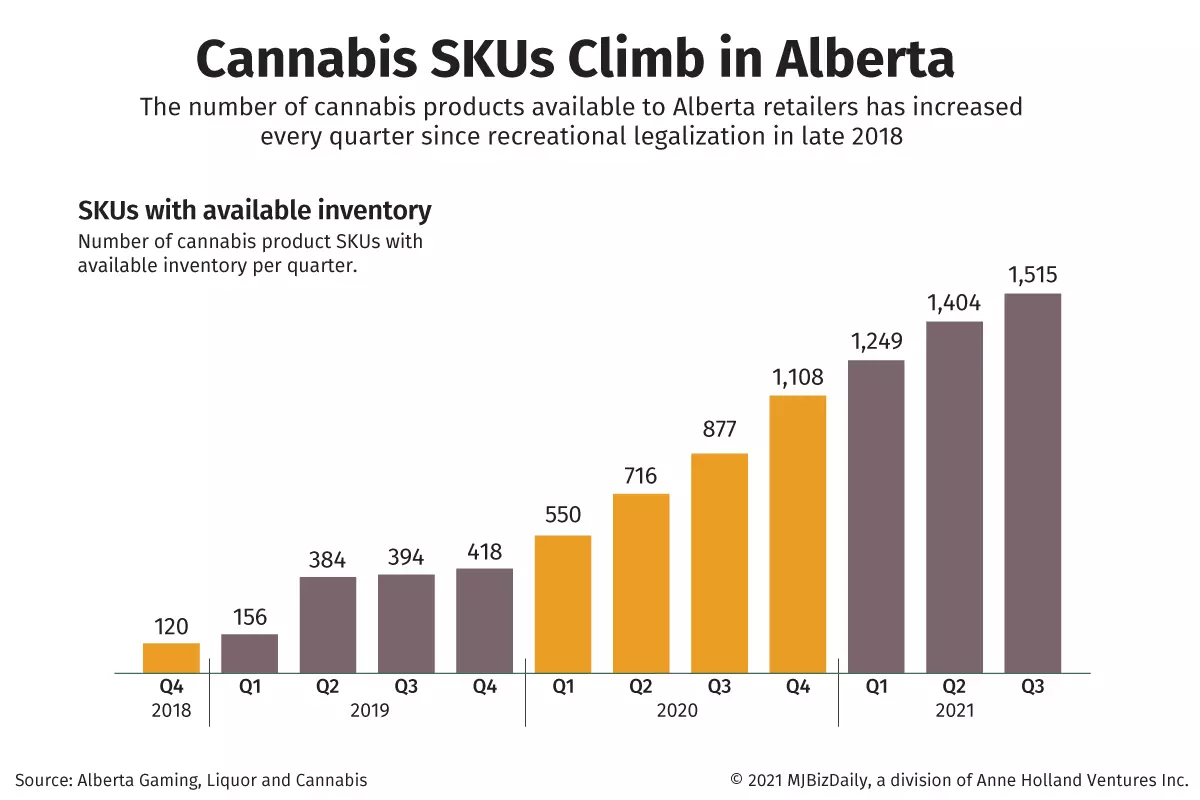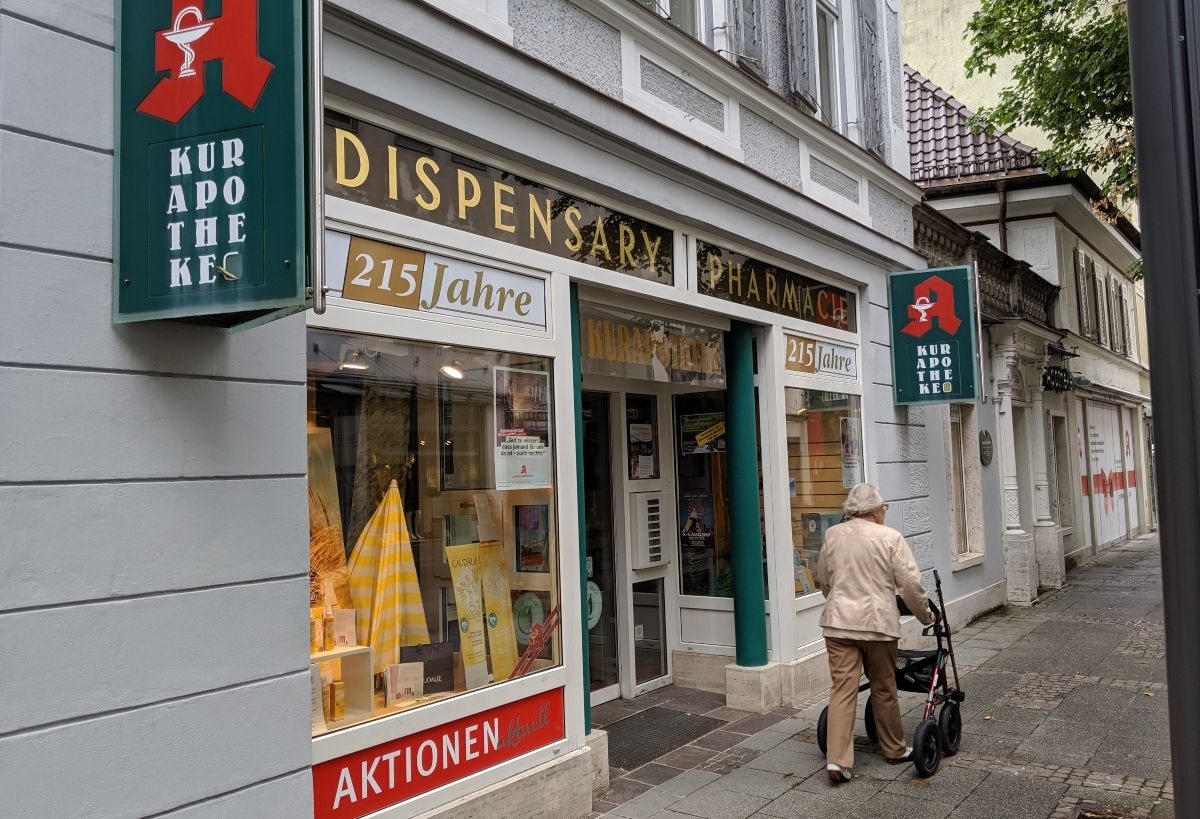Amid an ever-expanding constellation of cannabis products from a growing number of producers, retail product selection in Canada’s regulated recreational cannabis market has become a daunting task.
In response, retailers have fine-tuned their business models to navigate the staggering array of marijuana items and stand out from competitors that order from the same product catalogues.
In Alberta, the number of cannabis stock-keeping units (SKUs) with available inventory listed by recreational marijuana wholesaler Alberta Gaming, Liquor and Cannabis has surged from only 120 in the fourth calendar quarter of 2018 to 1,515 by the third quarter of this year.
“Now it’s becoming hard to keep up with, because there’s so much out there, so we do have to be a lot more selective,” said Koltaen Bushong, general manager of Northern Lights Supply, an independent retailer in Nisku, Alberta, near Edmonton International Airport.
Retailers interviewed by MJBizDaily described a variety of strategies to navigate the tidal wave of cannabis products, including:
- Leveraging data from multiple stores.
- Carefully researching producers’ methods to buy quality products sight unseen.
- Understanding consumer preferences, such as price sensitivity, interest in local products and a desire for distinct cannabis cultivars.
Meanwhile, those retailers said cannabis producers trying to find room on crowded store shelves can focus on strategies that include white-label opportunities, bulk formats and growing distinctive cultivars.
Different strokes for different stores
In the Ontario market – worth 141.6 million Canadian dollars ($110.9 million) in September – the Ontario Cannabis Store provincial marijuana wholesaler listed 1,842 active, in-stock SKUs excluding accessories in the second quarter of 2021, according to a recent quarterly report.
Stephen Fry, co-founder and CEO of Ontario retail chain Sessions Cannabis, has watched the SKU numbers climb since the recreational market launched in late 2018.
Stay informed with MJBiz Newsletters
MJBiz’s family of newsletters gives cannabis professionals an edge in this rapidly changing industry.
Featured newsletters:
- MJBizDaily: Business news for cannabis leaders in your inbox each morning
- MJBiz Cultivator: Insights for wholesale cannabis growers & vertically integrated businesses
- MJBizCon Buzz: Behind-the-scenes buzz on everything MJBizCon
- MJBiz Retail + Brand: New products, trends and news for cannabis retailers, distributors and marketers
- Hemp Industry Week: Roundup of news from hemp farming to CBD product manufacturing
- And more!
“I’m expecting another couple hundred products to come online in January,” Fry said.
Fry said Sessions’ strategy relies on carrying a huge variety of products in order to maximize sales.
“Our average store has just shy of 500 products on display at any given time.”
Within that enormous array of SKUs, Fry said Sessions relies on a tiered, good-better-best strategy to populate its product assortment.
“Anybody coming in our store is going to find something that they’re looking for, in some capacity.”
Some Canadian retailers take the opposite approach to product selection, carrying only a limited number of product SKUs.
Up in Smoke, an independent retailer in Vancouver, British Columbia, with roots in the unregulated market, carries only about 140 cannabis SKUs in a given week, said co-owner Maximillien Amato, who handles product selection.
Provincial wholesaler BC Liquor Distribution Branch currently carries roughly 700 different products, according to a spokesperson.
“We knew everyone’s buying the same product,” Amato explained.
“And so, to set ourselves apart, we wanted to work on our menu and do the best procuring we could and, that way, try and have some more niche products that not everyone’s going to carry.”
Larger chain stores might not want to buy a product with limited availability, “because they can’t buy it for all eight of their stores – there’s not enough,” Amato explained.
Carrying those limited-availability products helps make Up in Smoke different, he said.
Making the right choice
Whether retailers cast a wide product net or take a more discriminating approach, they still must make hard choices when it comes time to buy.
When buying new products without getting an opportunity to try them first, Amato relies on researching each producer and drawing conclusions from his own cannabis knowledge.
“I’ll look at everything right down from the soil that it’s grown in, the medium that it’s grown in, to the type of lighting they’re using, whether they’re using pesticides, whether they’re not.
“What’s their process for trimming? How big are their (grow) rooms, and how many lights are going?”
Alternatively, said Amato, it never hurts to buy a product from a competing store before making an inventory choice.
At Northern Lights Supply in Alberta, Bushong said it can be difficult to choose between multiple growers offering the same cannabis cultivars.
“There’s so many of the same strains out there … like Black Cherry Punch, there’s probably like six different growers doing that,” he said.
His customers tend to prefer the low-cost option.
Bushong also considers whether a producer will buy back SKUs that aren’t selling well, saving him from having to mark the items down for clearance.
“Generally, depending on the (licensed producer) they’ll come in and buy it back, and then we just purchase something else that we know is going to move, so we help each other.”
Bushong focuses on buying locally produced cannabis, which usually resonates with his customer base.
He advises independent stores to buy products that larger corporate competitors don’t carry.
“Because you’re going to end up in a price-matching war, and you’re never going to win.”
Sessions Cannabis’ Steven Fry said his buying team relies on data from the chain’s network, which is approaching 40 stores.
“We’ll test things in markets, and we’ll try different strategies within certain test markets, and then we’ll see if that’s effective, and then we’ll roll that out across the broader storefronts,” Sessions’ Fry said.
How producers can get on shelves
Canadian cannabis producers have to stand out from the pack to achieve coveted retail listings.
When retailers with limited ordering budgets have to pay for products upfront before they can sell them, Fry said, finding a way into retailers can be tricky.
From Fry’s point of view, new cannabis offerings tend to move.
“Customers do like new – I think between a budtender recommendation and the ‘newness’ factor, that helps with sales quite a bit in terms of moving new product.”
Fry also anticipates growing opportunities for white-label cannabis brands produced specifically for retailers, adding that Sessions is working on its own white-label offering.
National retail chains High Tide and Fire & Flower signed white-label deals this year.
In Alberta, Bushong observes customer interest in large-format packages, such as 28-gram offerings.
Customer preferences are evolving beyond simple THC content to consider terpene content, Bushong added.
“Now we’re seeing more and more customers coming in like, ‘What’s the terp level?’ And that’s been really nice to see.”
For producers trying to get top-shelf bud into stores, Up in Smoke’s Amato recommends pricing high – “but don’t price it out of the market.”
“Don’t mass-produce something that’s really good,” he advised.
“All the best things build hype over just doing little (production) runs – little run after little run.”
For those aiming to grow outstanding mass-produced midtier cannabis, Amato recommends focusing on uncommon genetics to get shoppers excited.
“Throw a little cookie strain in there, that you’re mass-producing, throw a little something like that, that’s got a bit of hype to it,” Amato said.
“So that consumer – which, let me tell you, is the majority of the market – this consumer that likes his midrange (cannabis), they can still feel like a bit of a baller.
“They can go, ‘Yeah, man, I paid 140 bucks for my ounce, and dude, it’s f***ing sick.'”
Solomon Israel can be reached at solomon.israel@mjbizdaily.com.





